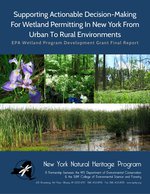Supporting Actionable Decision-Making for Wetland Permitting in New York from Urban to Rural Environments
Project Sponsor: US Environmental Protection Agency - Region 2 Wetland Program
End Date: June 30, 2017
Summary
Assessing connections between wetland ecological health and adjacent upland land use, we found upland buffers are important for managing the quality of NYS' wetland resources..
Highlights
- Putting a number on "good": Preliminary floristic quality and wetland condition benchmarks provide context, metrics, and a framework for quantifying wetland health - a first for New York State freshwater wetlands.
- Our re-calibrated New York Rapid Assessment Method (NYRAM ver. 5, "Level 2") for wetland condition produces more robust results that are easier to interpret.
- Our new ecological integrity metric ("Level 2.5") can be back-calculated using existing vegetation plot data. This metric was particularly informative for forested wetland systems where the impact of anthropocentric stressors and invasive species can be more subtle compare to marshes and shrub swamps.
- Preliminary floristic quality benchmarks ("Level 3") using weighted Coefficient of Conservatism can be used for wetland assessment and in developing restoration goals for NYS's non-tidal freshwater wetlands.
- Buffer condition: Tree canopy cover in the adjacent upland buffer is strongly linked to wetland health.
- Wetlands in good condition typically had forested land cover that extended ~42 meters (~138 ft) from the mapped wetland boundary.
- Degraded wetlands in poor condition typically had less than 30% forested land cover in the upland buffer.
- Historical land use legacies influence today's wetland ecological integrity - a trend that was even evident in today's urban landscapes.
- This result helps explain why we've found a few high quality wetlands in unlikely settings such as a urban parks. Wetlands that haven't been cleared in the past are likely to be in better condition in the present.
Project Summary
We refined our three-tiered wetland assessment methods (Shappell et al. 2016) and developed new protocols for quantifying the adjacent upland Area Of Influence (AOI) based on field and GIS data. We developed novel automated protocols for digitizing point-specific AOI, enabling us to calculate metrics such as maximum impervious surface and canopy cover. Level 1 AOI scores were compared to comparable scores generated for the contiguous wetland buffer, new rapid field buffer protocols, and our Level 3 Floristic Quality (FQ)metrics. We expanded our statewide coverage by including partner data from the Adirondack Park Agency, New York City-based Natural Areas Conservancy, and our National Wetland Condition Assessment surveys. Using existing data, we developed a new metric to reflect wetland integrity across these multiple datasets (Level 2.5). We compared performance (significance) of all metrics using cross-level validation and developed thresholds for describing wetland condition (good, fair, and poor). Our growing wetland database includes >200 survey sites ranging from pristine dwarf shrub bogs to urban maple-ash swamps and includes a diverse flora of 800+ vascular plant species.
Good floristic quality and wetland condition were negatively correlated with increasing stressors in the landscape. Recalibrating NYRAM (ver. 5) resulted in a more robust metric that strongly correlates with FQ; and when combined with threshold analysis, we find wetlands in good condition generally have FQ scores greater than 5.6 and NYRAM scores less than 38. We saw significant correlations between FQ and our AOI variables, but they performed no better than scores calculated for the contiguous wetland buffer. Further, wetlands in poor condition tended to have sparse canopy cover in the buffer immediately surrounding the wetland (less than 30%). Emergent and deciduous shrub wetlands strongly reflected stressors in the surrounding landscape with nearly a twofold difference in FQ scores between moderate- and minimally-developed environments. Unfortunately, localized Level 1 AOI-specific scores used in this project did not provide a clear method for quantifying the impacts from site-specific activities in upland areas on wetland condition. However, increased canopy cover in the upland buffer of the AOI was positively correlated with floristic quality. These results suggest wetland condition is influenced by several factors including land use history, landscape condition (LCA), and the overall integrity of the upland buffer (e.g., natural buffer width and canopy cover).
Final Report

Preferred Citation: Laura J. Shappell and Timothy G. Howard. 2018. Supporting Actionable Decision-Making For Wetland Permitting In New York From Urban To Rural Environments. EPA Wetland Program Development Grant. Final Report. New York Natural Heritage Program, Albany, NY. Final report (PDF, 7.3 MB).
Wetland Assessment Workshop (autumn 2016): Using NY Rapid Assessment Method (NYRAM ver. 4.2) for quantifying wetland condition
In partnership with the New York State Wetlands Forum (NYSWF), Laura Shappell co-led a one-day wetland assessment workshop in the Syracuse metro area at Beaver Lake Nature Center. Approximately 50 people attended, ranging from wetland professionals to students studying natural resources.
- Note: See the above 2018 project report for NYRAM ver. 5 field forms and metric calculation. Although field survey methods and raw data "input" are nearly the same as ver. 4.2, score calculation differs significantly between ver. 4.2 and ver. 5.0.
The following documents were provided as handouts to attendees (NYRAM ver. 4.2, last updated Nov. 2016):
- NYRAM ver. 4.2 User’s Manual and Data Sheets (PDF 1.2 MB)
- NYRAM ver. 4.2 Excel worksheets (XLSX, 238 KB) - including automated calculations
- NYRAM ver. 4.2 Example site: Beaver Lake Excel worksheets (XLSX, 1.0 MB) - NYRAM was presented during a New York State Wetlands Forum (NYSWF) workshop on wetland assessment, held at Beaver Lake Nature Center, Baldwinsville, NY. This file is the results from that survey, and may serve as an example for how to use the excel worksheet.
- Upland Adjacent Area Rapid Assessment Method (UP-RAM) Form Excel Version (XLSX, 30.5 KB)
Research Topics/Keywords
adjacent land use/land cover (LULC), ecological integrity, historical land use/land cover, rapid assessment method, three-tiered assessment, upland buffer, wetland condition assessment, wetland floristic quality, wetland monitoring
Dec. 9, 2020 | Updated Feb. 22, 2023, 5:05 p.m.